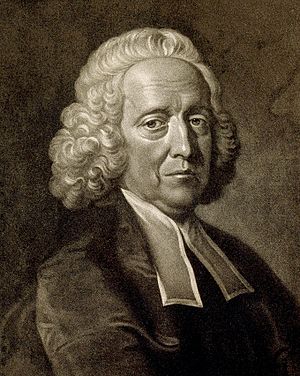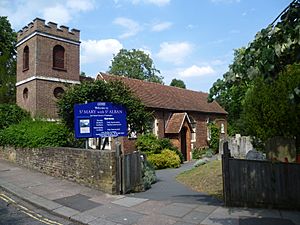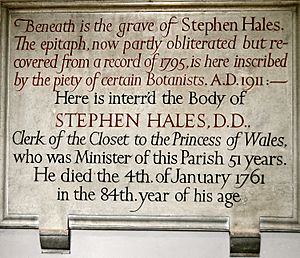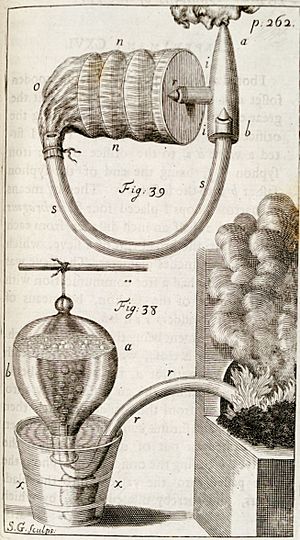Stephen Hales facts for kids
Quick facts for kids
Stephen Hales
|
|
|---|---|

Stephen Hales, aged 82, by J. McArdell after T. Hudson
|
|
| Born | 17 September 1677 Bekesbourne, Kent
|
| Died | 4 January 1761 (aged 83) |
| Nationality | English |
| Awards | Copley Medal (1739) |
| Scientific career | |
| Fields | |
Stephen Hales (born September 17, 1677 – died January 4, 1761) was an English clergyman who made big discoveries in science. He helped us understand plants, chemistry, and how living things work (physiology).
He was the first person to measure blood pressure. He also invented many useful things. These included a machine to improve air (ventilator) and tools for surgery. Hales was also a kind person who helped others (philanthropist).
Contents
Life of Stephen Hales
Stephen Hales was born in Bekesbourne, Kent, England. He was one of many children in his family. His father was Thomas Hales.
He went to school in Kensington and Orpington. In 1696, he started studying at Corpus Christi College, Cambridge. He studied religion, but also learned about mathematics, natural sciences, and philosophy. He became friends with William Stukeley, who was studying medicine. Hales became very interested in biology, botany, and how bodies work (physiology) during this time.

In 1709, Hales became a priest. He was appointed to lead the church in Teddington, Middlesex. He stayed there for the rest of his life. He was a very dedicated minister. He even helped fix up the church and get new water for the village.
Some people, like the poet Alexander Pope, were worried about Hales's experiments on animals. Pope wondered if humans had the right to harm animals for science. However, Pope was also a close friend of Hales. He saw Hales as a good person who loved God.
In 1718, Stephen Hales became a member of the Royal Society. This was a very important group for scientists. He also became a rector in Porlock, Somerset.
Hales married Mary Newce in 1720, but she died the next year. They did not have any children, and he never married again.
His fame as a scientist grew a lot after 1718. He became known around the world. He was even a member of the Royal Academy of Sciences in Paris. In 1739, he won the Copley Medal, a major science award. He also became well-known for speaking out against too much drinking.
Later in his life, Prince Frederick and his wife, Princess Augusta, often visited Hales. They liked gardening and plants. Hales gave Princess Augusta advice for Kew Gardens.
Stephen Hales died in Teddington on January 4, 1761, when he was 83. He was buried under the church tower where he had worked for so long. Princess Augusta later put up a monument for him in Westminster Abbey.
Stephen Hales's Scientific Work
Hales is most famous for his books called Statical Essays. The first book, Vegetable Staticks (1727), was about his experiments with plants and chemistry. The second book, Haemastaticks (1733), described his work on how animal bodies work. This included measuring blood pressure.
Plant Physiology and Air Chemistry
In Vegetable Staticks, Hales studied how plants lose water. This process is called transpiration. He measured how much water plants took in through their roots. He also measured how much water left the plant through its leaves. He thought that plants might get some food from the air through their leaves.
Hales also suggested that plants might use light for energy to grow. This idea was similar to what we now call photosynthesis. His work helped us understand how plants breathe and use air.
Hales also invented the pneumatic trough. This was a special tool used to collect gases over water. Other famous scientists later used and improved this invention.
Animal Physiology Discoveries
Hales started studying how animal bodies work while he was at Cambridge. He did many experiments. One of his most famous experiments was measuring blood pressure in animals. He put thin tubes into arteries to see how high the blood would rise.
He also studied what happens when animals lose a lot of blood. He described how the heart pumps blood. He also explained how arteries stretch and shrink with each heartbeat. Hales realized that tiny blood vessels made it harder for blood to flow.
Hales also tried to find ways to dissolve bladder stones. He didn't succeed, but he invented a special catheter and forceps to help remove these stones.
He also showed how long bones grow. He studied how reflexes work in frogs. Hales even thought that electricity might help nerves control muscles.
Inventions and Other Work
In the 1700s, people thought "bad air" caused sickness. This was a big problem on crowded ships and in prisons. Stephen Hales invented ventilators to make the air better. His ventilators were large bellows that moved air. They were used on ships, in prisons, and in mines. These machines helped reduce sickness and improve air quality.
Hales also worked on other inventions. He tried to turn sea water into fresh drinking water. He also looked for ways to keep water and meat fresh on long sea trips. He even wrote about earthquakes and how to stop fires.
Helping Others: Philanthropy
After his wife died, Hales spent more time helping others. He became involved with groups that helped people.
He became a trustee for a plan to create a new colony for poor people. This colony was called Georgia. It was special because it did not allow slavery or rum. Hales's own brothers had faced problems with debt, so he felt strongly about helping others in need.
Because of his work with the Georgia colony, Hales learned about the problems on crowded ships. This led him to invent his ship ventilator. He also worked on ways to get fresh water from the sea and preserve food for sea voyages.
Hales also helped start the Royal Society of Arts. This group encouraged new inventions and businesses. He also spoke out against drinking too much gin. He wrote articles and talked to Parliament about this issue.
Legacy of Stephen Hales
The type of trees called Halesia were named after him in 1759. The American Society of Plant Biologists gives out the Stephen Hales Prize every year. This award honors scientists who do important work in plant biology.
See also
- Pneumatic chemistry
- Physiology
- Botany
- History of botany
 In Spanish: Stephen Hales para niños
In Spanish: Stephen Hales para niños





